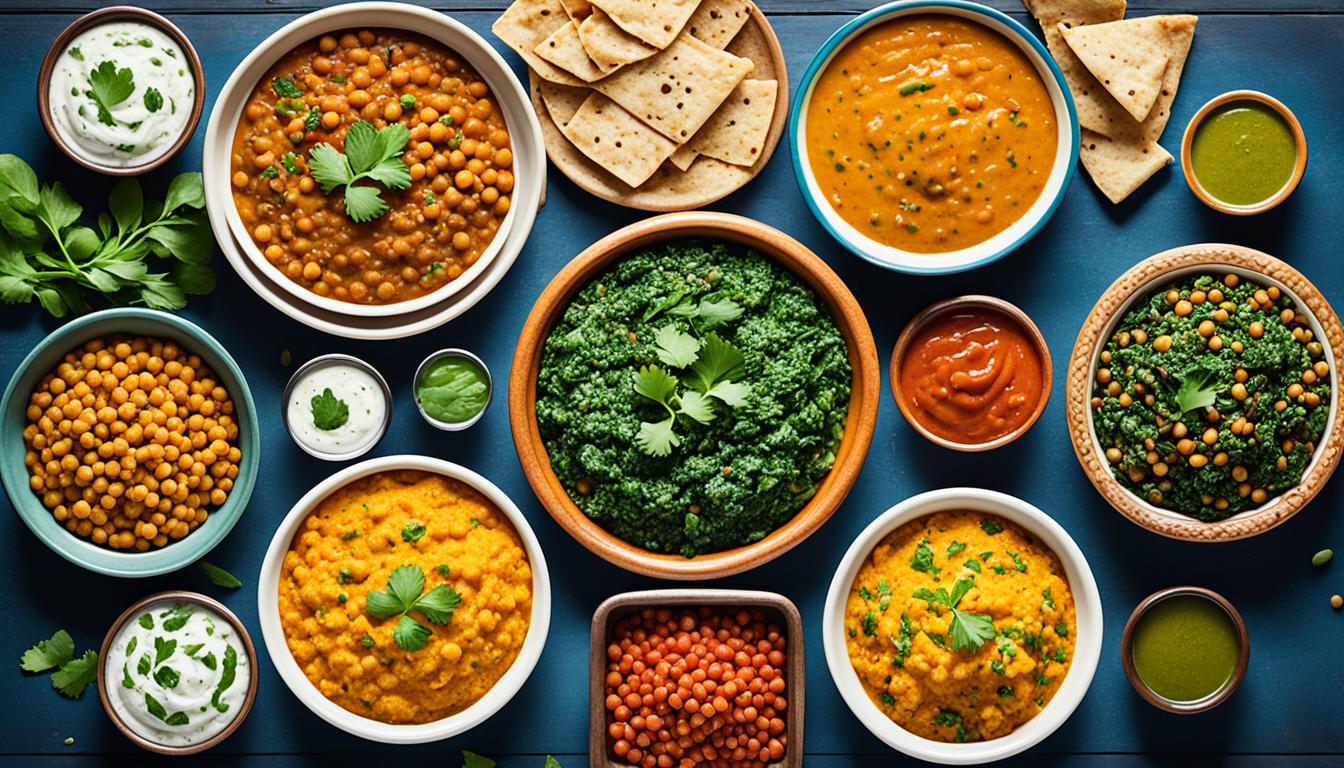FTC disclaimer: This post may contains affiliate links and we will be compensated if you click on a link and make a purchase.
Did you know kids aged 9 to 13 need a lot of fiber each day? Boys should get 31 grams, and girls need 26 grams. Fiber-rich Indian foods make it easy to hit these goals. They also bring lots of health benefits. Think lentils, whole grains, and colorful fruits and veggies. These foods are not only tasty but also great for your health.
Key Takeaways
- The recommended daily fiber intake for children, men, and women varies significantly.
- Indian cuisine offers a wide array of high-fiber foods, including lentils, whole grains, fruits, and vegetables.
- Fiber-rich foods provide numerous health benefits, such as improved digestion, weight management, and reduced risk of chronic diseases.
- Incorporating diverse high-fiber Indian ingredients into your meals can help you meet your daily fiber goals.
- Exploring the fiber-packed wonders of Indian cuisine is a delicious way to boost your overall health and wellness.
Introduction to Fiber and Its Importance
Fiber is a carb in plants that is good for us but our bodies can’t break it down. It’s vital for our health and we need to know about it for staying well.
What is Fiber?
Fiber is a carb that our bodies can’t break down. Instead, it moves through our stomach and gut, helping us in many ways.
Types of Fiber: Soluble and Insoluble
Dietary fiber is of two kinds: soluble and insoluble. Soluble fiber mixes with water. It gives us energy. Insoluble fiber does not mix with water. It helps us have normal bowel movements.
Benefits of Eating a High-Fiber Diet
A diet high in fiber is very good for us. These foods are not so rich in fat. Eating a lot of fiber lowers our chances of getting sick with heart issues, strokes, high blood pressure, diabetes, and being too heavy. It helps us stay a good weight, control our blood sugar, and boosts our immune system.
Fiber also helps our gut stay healthy. Soluble fiber keeps our cholesterol in check and stabilizes our blood sugar. Insoluble fiber stops constipation and gets rid of harmful stuff. A diet with lots of fiber is key to good health and helps prevent many sicknesses.
Fiber is a must in our diets. Knowing the types of fiber and what they do helps us be healthier. Adding fiber foods like fruits, veggies, whole grains, beans, and nuts can get us to 30 grams of fiber daily, which is what’s recommended.
Fiber-Rich Fruits in India
India is full of rich, fiber-packed fruits. They give you vital nutrients and make eating fiber fun.
Guava
Guava is packed with fiber. A medium guava has about 8.9 grams, meeting 12% of your daily needs. This fruity tropical delight adds a sweet crunch to your diet.
Pears (Nashpati)
Pears, or nashpati, are great for fiber too. A medium pear has over 5 grams of fiber, keeping you full and healthy. They’re perfect at mealtime or as a quick snack.
Berries
Berries like strawberries and blackberries have lots of fiber. Raspberries stand out with 8 grams of fiber in a one-cup serving. They’re a tasty way to get more fiber.
Apples
Apples are also full of fiber. A medium apple has about 4 grams, helping you stay full and healthy. They’re an easy, yummy addition to any meal.
Bananas
Bananas, especially when they’re green, are fiber stars. A medium banana offers 3.5 grams of fiber, which is great for your belly and your health. Include bananas in your diet for a fiber and nutrient boost.
Adding these Indian fruits to your day makes getting enough fiber easy and enjoyable. This supports your overall health.
High Fiber Indian Foods: Vegetables
Adding high-fiber veggies to your meals is a smart move for better health. India offers a wide range of fiber-rich vegetables. Including them in your diet is easy and beneficial. Here are some top choices.
Okra, or bhindi, is a great source with 7 grams of fiber in just one cooked cup. Eggplant, a popular choice, has 5 grams of fiber per cup. Fenugreek leaves, known as methi, add 4 grams of fiber to your meal in a cup.
Other high-fiber options include cauliflower with 3 grams per cup. Carrots have over 3 grams of soluble and insoluble fiber in a cup. Their fiber is also easier to digest when cooked. Last but not least, spinach offers more than 4 grams of fiber in a cooked cup.
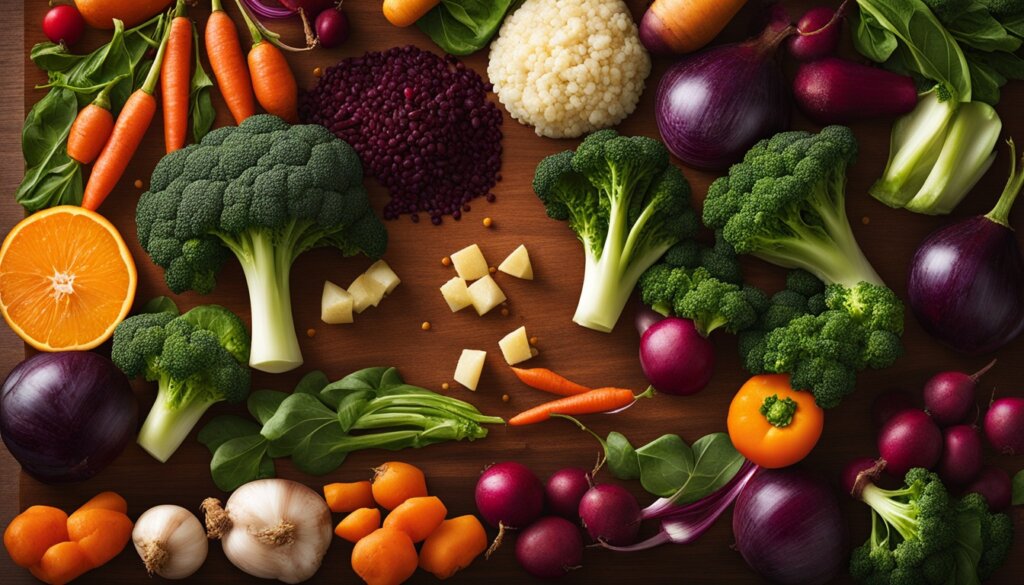
Adding these veggies to your meals is easy and tasty. You can use them in curries, stir-fries, salads, and roasts. The choices are unlimited. Try various ways of cooking and find your favorite high-fiber Indian dishes.
Vegetable | Fiber Content (per cup) |
|---|---|
Okra (Bhindi) | 7 grams |
Eggplant | 5 grams |
Fenugreek (Methi) | 4 grams |
Cauliflower | 3 grams |
Carrots | Over 3 grams |
Spinach | Over 4 grams |
Lentils and Legumes: Powerhouses of Fiber
Lentils and legumes are key players in the high-fiber game. They are packed with fiber and essential nutrients. These foods are crucial for a healthy diet.
Chickpeas (Chole)
Chickpeas, called ‘chole’ in India, are high in fiber. One serving has 8 grams of fiber. This makes them both tasty and filling. They are used in a variety of Indian meals, like curries and salads.
Lentils/Dals
Indian lentils, or ‘dals,’ are also fiber-rich. Cooked lentils have 7.8 grams of fiber and 58 calories. They’re a smart choice for any dish. With types like brown, green, and red, everyone can find a favorite.
Beans
Beans, which include ‘rajma’ (kidney beans), are fiber giants too. One serving gives you 5.5 grams of fiber and 108 calories. These legumes are full of valuable protein and fiber types.
Eating lentils and legumes can greatly help your health. People in India have eaten lentils for thousands of years. They help lower heart disease risk. This shows how vital they are for our diets.
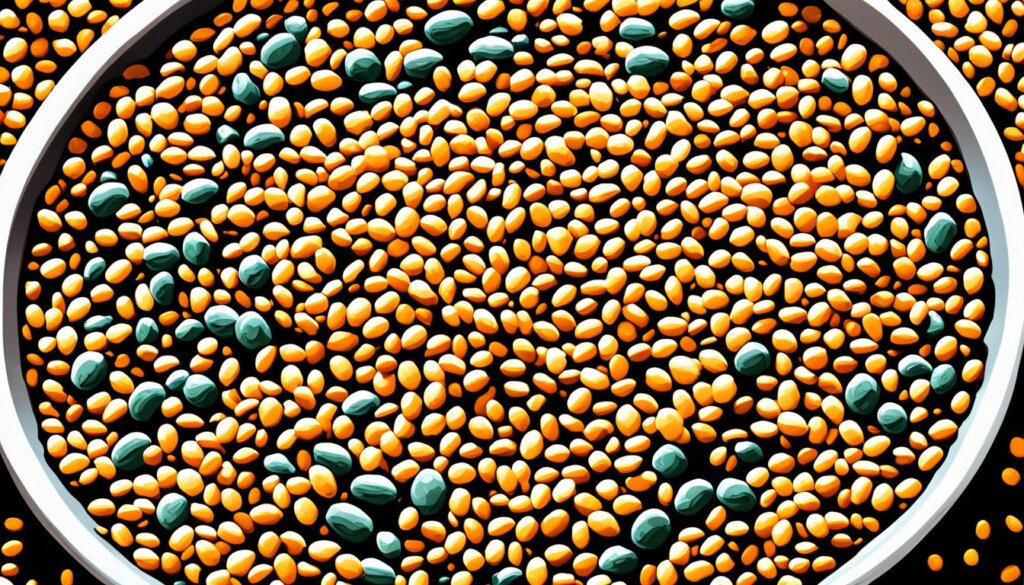
Chow down on lentil dal, chickpea curry, or every bean dish. These Indian fiber stars will make you and your taste buds happy.
Wholesome Whole Grains for Fiber
Looking to add more fiber to your diet? Turn to whole grains. Foods like brown rice and oatmeal are packed with fiber. These fiber whole grains are great for your health.
Brown Rice
Brown rice is a top choice for high fiber whole grains. It gives you 3.5 grams of fiber and 218 calories per serving. It keeps the nutritious bran layer, unlike white rice, boosting its health benefits.
This makes it a better option for your meals.
Oatmeal
Oatmeal is also a fantastic high fiber whole grain. One serving has 3 grams of fiber and 124 calories. It’s full of important vitamins, minerals, and antioxidants. Its soluble fiber helps lower blood sugar levels, which is great for people with diabetes.
Eating high fiber whole grains like brown rice and oatmeal is easy. It can make a big difference for your health.
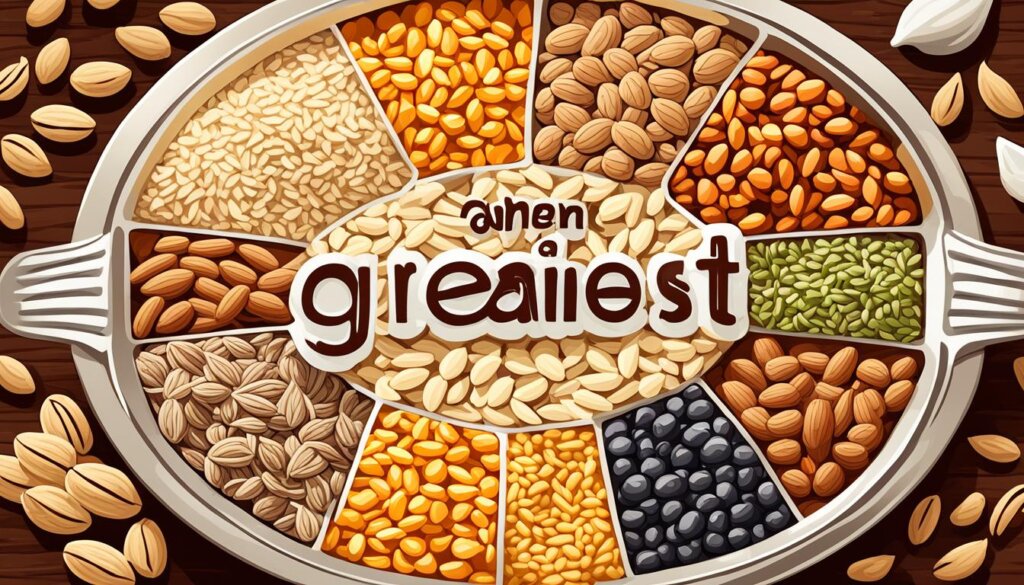
“Fiber is key for the health of good gut bacteria. It helps with digestion, boosts immunity, and supports getting nutrients from food.”
Choosing brown rice and oatmeal often can up your whole grain and fiber intake. This leads to many health benefits.
High Fiber Indian Foods: Nuts and Seeds
The humble nut and seed are great for more fiber in your diet. They’re packed with nutrition and easy to add to daily meals. India has many top choices for high-fiber nuts and seeds.
Almonds
Almonds are called the “king of nuts” for good reason. They have a lot of fiber, 4.5 grams per serving. Even though they have 207 calories per serving, they can help you get enough fiber. Adding almonds to what you eat is a simple way to raise your fiber and stay healthy.
Sunflower Seeds
Sunflower seeds are another fiber-rich pick. They give you 4 grams of fiber in one serving. You can eat them as a snack, put them on salads, or in baked goods. Sunflower seeds bring lots of vitamins, minerals, and healthy fats to a fiber-filled diet.
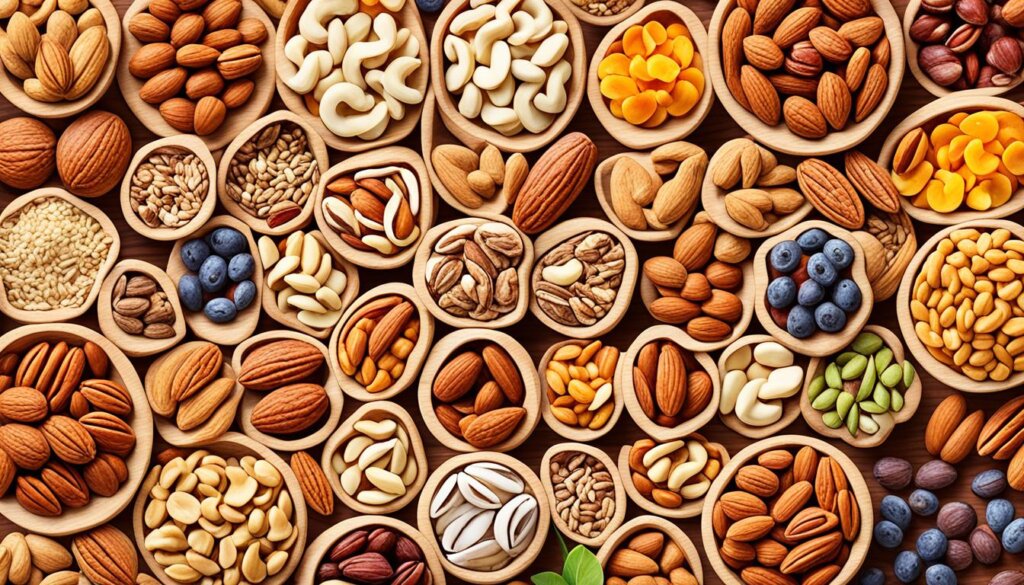
“Nuts and seeds are a game-changer when it comes to boosting your fiber intake. From almonds to sunflower seeds, these nutrient-dense options offer a delicious way to nourish your body.”
Eating more high-fiber nuts and seeds helps you get your daily fiber. It’s easy to do and comes with many health perks. Whether you like almonds or sunflower seeds, they make your meals and snacks better.
Unique Indian Veggies Rich in Fiber
Many vegetables are great for fiber, but some Indian ones are really high. We’ll look at okra, eggplant, and fenugreek, which are full of fiber.
Okra (Bhindi)
Okra, or “bhindi” in India, is known for its 7 grams of fiber in a cooked cup. It’s loved for adding a crunch to dishes like curries and stir-fries.
Eggplant
Eggplant has about 5 grams of fiber in a single cooked cup. Its spongy and savory nature makes it perfect for favorites like baingan bharta and eggplant curry.
Fenugreek (Methi)
Fenugreek, known as “methi,” surprises with 4 grams of fiber in a cooked cup. Its unique taste enhances dishes, from curries to dals.
These veggies not only bring fiber but also add color and flavor to Indian meals. They’re a tasty way to boost your health.
“Fiber-rich vegetables like okra, eggplant, and fenugreek are not only nutritious but also add depth and complexity to traditional Indian dishes.”
Sauteing okra or cooking up a methi curry can introduce you to fiber-packed dishes. Exploring Indian cuisine’s fiber-rich foods is both healthy and delicious.
Fiber-Packed Snacks and Treats
Adding high-fiber snacks and treats to your day can make fiber intake fun. Dried fruits and coconut are great options for this.
Dried Fruits
Figs, prunes, and dates are dry, easy to carry, and full of fiber. They have about 7 grams of fiber in a half-cup. By taking out the water, their fiber is more concentrated. This makes them a tasty, handy choice for getting more fiber.
Coconut
Coconut is rich in fiber too, both kinds, soluble and insoluble. It can lower your cholesterol and keep your heart healthy. You can eat coconut as it is, or add it to meals and drinks for extra fiber.
Picking fiber-rich snacks and treats is an easy step to better eating. They take care of your hunger and health.
“Eating high-fiber foods helps in feeling full longer, aiding in appetite and weight control.”
By adding dried fruits, coconut, and other fiber-rich foods to what you eat every day, health gets a boost. You get better at digesting food, keep blood sugar under control, and lower your chances of getting sick.
Cooking with High Fiber Indian Foods
Adding fiber-rich Indian foods to your diet is easy and fun. It boosts your health in a tasty way. Use lentils, whole grains, and lots of veggies and fruits. You’ll make meals that are both yummy and good for you.
Lentils, known as dals, have many uses. You can make them into hearty curries or thick porridges. Brown rice and oatmeal are great in recipes, from spicy biryanis to healthy breakfasts. Don’t forget to add fiber-full fruits and veggies to your dishes.
It’s important to get enough fiber every day. Women need about 25 grams if they’re under 50, and 21 grams if they’re over 50. Men should aim for 30-38 grams a day. For every 1,000 calories, try to eat 14 grams of fiber. With Indian ingredients, you can easily hit these goals and stay healthy.
When choosing Indian breads, rotis, pick the ones with 1 to 1.5 grams of fiber. Foods like chia seeds, flax seeds, and quinoa are super high in fiber. They’re great choices for a fiber-rich diet.
Fiber is really good for you. It helps your heart, fights diabetes, and keeps your weight in check. It’s found in whole grains, fruits, veggies, and seeds like flax. Try to eat more of these foods.
Indian subzis or veggie dishes are great for your gut. They keep you feeling full, too. Also, giving kids fiber-rich snacks is a smart move.
For breakfast, go for high-fiber foods like quinoa. They’re good for you and keep you full. Salads and snacks like oats dosa are tasty ways to get more fiber.
Want to support your digestion, blood sugar, or lose weight? Cooking with Indian high-fiber foods can help. There’s a lot of recipes, from curries to salads. Start eating more fiber today and enjoy the benefits.
Conclusion
India’s diverse food offers many fiber-rich fruits, vegetables, lentils, and whole grains. Adding these healthy choices to your meals is simple. It can help your digestion, manage weight, cut down cholesterol, and lower disease risks.
India’s rich cuisine is full of fiber. It offers tasty and nourishing dishes, boosting your health. With plenty of fruits, veggies, lentils, and grains, Indian cooking has everything you need for daily fiber goals. This supports overall health.
Eating Indian dishes packed with fiber is an easy and good way to care for your health. By choosing these foods often, you’ll enjoy a diet rich in fiber. This keeps you healthy and happy.
FAQ
What is fiber and why is it important?
Fiber is a carb in plants that our bodies can’t fully break down. It comes in two forms. Soluble fiber mixes with water and gives energy. Insoluble fiber doesn’t mix with water and helps our digestion. Eating lots of fiber helps keep you regular and lowers heart disease risk.
What are the benefits of a fiber-rich diet for children?
Fiber helps kids go to the bathroom and take in nutrients better. It also helps manage weight and could lower the chance of getting diabetes.
What are some high-fiber fruits and vegetables in Indian cuisine?
in India, guava, pears, berries, apples, and bananas are high in fiber. For veggies, okra, eggplant, fenugreek leaves, and cauliflower have lots of fiber. Carrots and spinach are good sources too.
What are the fiber-rich lentils, legumes, and grains in Indian food?
Lentils, chickpeas, and beans are full of fiber. These include kidney beans too. Brown rice and oatmeal are great whole grains rich in fiber.
What are some high-fiber nuts and seeds in Indian cuisine?
Almonds and sunflower seeds are good choices for fiber. Almonds have 4.5 grams in a serving. Sunflower seeds offer 4 grams of fiber per serving.
What are some unique high-fiber Indian vegetables?
Okra, or ‘bhindi’, gives 7 grams of fiber in each cooked cup. Eggplant has 5 grams in a cup. Fenugreek leaves, or ‘methi’, have 4 grams of fiber per cooked cup.
What are some high-fiber snacks and treats in Indian food?
Figs, prunes, and dates are easy, fiber-filled snacks. They can have up to 7 grams of fiber in half a cup. Coconut is also good for fiber and has healthy fats.
How can you incorporate high-fiber Indian foods into your diet?
You can add lentils, whole grains, fruits, and veggies into many meals. Use lentils in curries or porridges. Add brown rice and oatmeal to your dishes. Include high-fiber veggies and fruits in salads, smoothies, and other foods.
